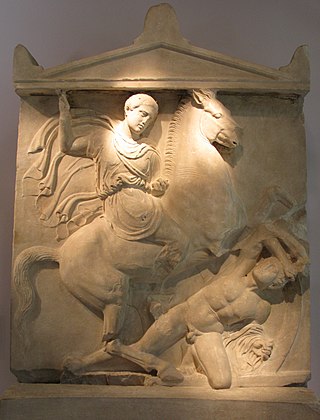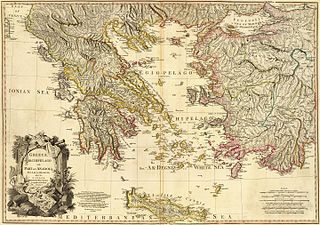Related Research Articles

Hoplites were citizen-soldiers of Ancient Greek city-states who were primarily armed with spears and shields. Hoplite soldiers used the phalanx formation to be effective in war with fewer soldiers. The formation discouraged the soldiers from acting alone, for this would compromise the formation and minimize its strengths. The hoplites were primarily represented by free citizens – propertied farmers and artisans – who were able to afford a linen or bronze armour suit and weapons. They also appear in the stories of Homer, but it is thought that their use began in earnest around the 7th century BC, when weapons became cheap during the Iron Age and ordinary citizens were able to provide their own weapons. Most hoplites were not professional soldiers and often lacked sufficient military training. Some states maintained a small elite professional unit, known as the epilektoi or logades because they were picked from the regular citizen infantry. These existed at times in Athens, Sparta, Argos, Thebes, and Syracuse, among other places. Hoplite soldiers made up the bulk of ancient Greek armies.

Argos is a city and former municipality in Argolis, Peloponnese, Greece and is one of the oldest continuously inhabited cities in the world, and one of the oldest in Europe. It is the largest city in Argolis and a major center in the same prefecture, having nearly twice the population of the prefectural capital, Nafplio.
Cleomenes I was Agiad King of Sparta from c. 524 to c. 490 BC. One of the most important Spartan kings, Cleomenes was instrumental in organising the Greek resistance against the Persian Empire of Darius, as well as shaping the geopolitical balance of Classical Greece.

Tegea was a settlement in ancient Arcadia, and it is also a former municipality in Arcadia, Peloponnese, Greece. Since the 2011 local government reform it is part of the Tripoli municipality, of which it is a municipal unit with an area of 118.350 km2. It is near the modern villages of Alea and Episkopi.
Agis II was the 18th Eurypontid king of Sparta, the eldest son of Archidamus II by his first wife, and half-brother of Agesilaus II. He ruled with his Agiad co-monarch Pausanias.
At the Battle of Sepeia, the Spartan forces of Cleomenes I defeated the Argives, fully establishing Spartan dominance in the Peloponnese. The Battle of Sepeia is infamous for having the highest number of casualties within a battle during the classical Greek period.

The Corinthian War was a conflict in ancient Greece which pitted Sparta against a coalition of city-states comprising Thebes, Athens, Corinth and Argos, backed by the Achaemenid Empire. The war was caused by dissatisfaction with Spartan imperialism in the aftermath of the Peloponnesian War, both from Athens, the defeated side in that conflict, and from Sparta's former allies, Corinth and Thebes, who had not been properly rewarded. Taking advantage of the fact that the Spartan king Agesilaus II was away campaigning in Asia against the Achaemenid Empire, Thebes, Athens, Corinth and Argos forged an alliance in 395 BC with the goal of ending Spartan hegemony over Greece; the allies' war council was located in Corinth, which gave its name to the war. By the end of the conflict, the allies had failed to end Spartan hegemony over Greece, although Sparta was weakened by the war.
Pheidon was an Argive ruler, usually dated to the first half of the 7th century BCE. While his dating is a matter of dispute and much of the information about him is fragmentary, he is almost always described as a powerful and expansionist ruler. He consolidated Argive control over the surrounding region of the Argolid. If the 7th-century dating is correct, then he defeated Sparta at the Battle of Hysiae in 669/8. He is also remembered for forcibly taking control of the presidency over the Olympic games and creating or standardizing weights and measures which were then used throughout the Peloponnese and called Pheidonian after him. He may have intervened in the affairs of other Greek city-states on other occasions, and one late author claims that he died while involved in civil conflict in Corinth. He was remembered as a tyrant, perhaps for his demonstration of power at the Olympic festival.

Warfare occurred throughout the history of Ancient Greece, from the Greek Dark Ages onward. The Greek 'Dark Ages' drew to an end as a significant increase in population allowed urbanized culture to be restored, which led to the rise of the city-states (Poleis). These developments ushered in the period of Archaic Greece. They also restored the capability of organized warfare between these Poleis. The fractious nature of Ancient Greek society seems to have made continuous conflict on this larger scale inevitable.

Phlius or Phleius (Φλειοῦς) was an independent polis (city-state) in the northeastern part of Peloponnesus. Phlius' territory, called Phliasia (Φλιασία), was bounded on the north by Sicyonia, on the west by Arcadia, on the east by Cleonae, and on the south by Argolis. This territory is a small valley about 900 feet (270 m) above the level of the sea, surrounded by mountains, from which streams flow down on every side, joining the river Asopus in the middle of the plain. The mountain in the southern part of the plain, from which the principal source of the Asopus springs, was called Carneates (Καρνεάτης). The territory of Phlius was celebrated in antiquity for its wine. According to Strabo, the ancient capital of the country was Araethyrea (Ἀραιθυρέα) on Mt. Celosse, which city is mentioned by Homer; but the inhabitants subsequently deserted it and built Phlius at the distance of 30 stadia. Pausanias, however, does not speak of any migration, but says that the ancient capital was named Arantia (Ἀραντία), from its founder Aras, an autochthon, that it was afterwards called Araethyrea from a daughter of Aras, and that it finally received the name of Phlius, from Phlias, a son of Ceisus and grandson of Temenus. The name of Arantia was retained in the time of Pausanias in the hill Arantinus, on which the city stood. Hence the statement of grammarians that both Arantia and Araethyrea were ancient names of Phlius. According to Stephanus of Byzantium, Phlius derived its name from Dionysus and Chthonophyle. Phlius was subsequently conquered by Dorians under Rhegnidas, who came from Sicyon. Some of the inhabitants migrated to Samos, others to Clazomenae; among the settlers at Samos was Hippasus, from whom Pythagoras derived his descent.

The Spartan army was the principle ground force of Sparta. It stood at the center of the ancient Greek city-state, consisting of citizens trained in the disciplines and honor of a warrior society. Subjected to military drills since early manhood, the Spartans became one of the most feared and formidable military forces in the Greek world, attaining legendary status in their wars against Persia. At the height of Sparta's power—between the 6th and 4th centuries BC—other Greeks commonly accepted that "one Spartan was worth several men of any other state."
The Second Messenian War was a war which occurred ca. 660–650 BC between the Ancient Greek states of Messenia and Sparta, with localized resistance possibly lasting until the end of the century. It started around 40 years after the end of the First Messenian War with the uprising of a slave rebellion. Other scholars, however, assign earlier dates, claiming, for example, that 668 BC is the date of the war's start, pointing at Sparta's defeat at the First Battle of Hysiae as a possible catalyst for the uprising. Current events concerning this war are stated, too.

The history of Sparta describes the history of the ancient Doric Greek city-state known as Sparta from its beginning in the legendary period to its incorporation into the Achaean League under the late Roman Republic, as Allied State, in 146 BC, a period of roughly 1000 years. Since the Dorians were not the first to settle the valley of the Eurotas River in the Peloponnesus of Greece, the preceding Mycenaean and Stone Age periods are described as well. Sparta went on to become a district of modern Greece. Brief mention is made of events in the post-classical periods.

Pyrrhus' invasion of the Peloponnese in 272 BC was an invasion of south Greece by Pyrrhus, King of Epirus. He was opposed by Macedon and a coalition of Greek city-states (poleis), most notably Sparta. The war ended in a joint victory by Macedonia and Sparta.
The second Battle of Hysiae between the armies of Argos and Sparta took place in 417 BC during the Peloponnesian War, directly following Sparta's decisive defeat of the Argive/Athenian alliance in the Battle of Mantinea the year before.
The Battle of Orneae was an engagement that took place in the winter of 417 BC during the Peloponnesian War in the city of Orneae, between a Spartan garrison left in Orneae after the Battle of Hysiae and the forces of Argos and Athens.
Pheidon I was a king of Argos in the 8th century BC, and seems to have been a son of Temenus, a great-great-grandson of Heracles. He is often confused with another king of Argos also named Pheidon, who was probably one of his descendants.

There is evidence of mercenaries being hired in Ancient Greece from the 6th century BC. The tyrants of that time hired bodyguards from other city-states. It is not known if earlier Aegean armies and navies, such as the Minoans and Mycenaeans, used mercenaries.
Hysiae or Hysiai, also Hysia (Ὑσία), was a garrison town of ancient Argolis, also called the Argeia, Southern Greece during the archaic period. It was located to the southwest of Argos and east of Tegea, on the road between them, at the foot of Mount Parthenium, not far from the Argive border with Laconia. In c. 669 BCE, the First Battle of Hysiae was fought between the Spartans and the Argives, who won to repulse a Spartan invasion of Argolis. It appears to have been destroyed by the Argives, along with Tiryns, Mycenae, and the other towns in the Argeia, after the Greco-Persian Wars; but it was afterwards restored, and was occupied by the Argives in the Peloponnesian War as a frontier-fortress. During the Peloponnesian War, in 417 BCE, the Second Battle of Hysiae was fought, again between the Spartans and the Argives, and resulted in a decisive Spartan victory. The Spartans captured Hysiae and destroyed it; all captured male citizens were executed.
References
- 1 2 3 Pausanias, ii. 24. § 7.
- ↑ Dictionary of Greek and Roman Geography, vol. I, pp. 203 ("Argos"), 1108 ("Hysiae").
- ↑ Battle of Hyisiai. Archived from the original on 8 March 2018. Retrieved 19 April 2017.
But at Argos they made the aspis larger and tougher
{{cite book}}: CS1 maint: unfit URL (link) - ↑ Battle of Hyisiai. Archived from the original on 8 March 2018. Retrieved 19 April 2017.
{{cite book}}: CS1 maint: unfit URL (link) - ↑ Princeton Encyclopedia of Classical Sites, p. 401 ("Hysiai").
- ↑ Andrewes, The Greek Tyrants, pp. 40, 74.
- 1 2 Hall, History of the Archaic Greek World, pp. 145–154.
- ↑ Kelly, "Did the Argives Defeat the Spartans at Hysiae in 669 B. C.?"